The importance of sustainability for consumers and companies has only been growing. The challenge? There is both long term potential if companies transform and risks if sustainability topics are left unaddressed. In our global, cross-industry study, we explore consumers’ attitudes toward sustainability – and their willingness to pay for it!
“Sustainability is in demand” – as consumers embrace sustainability and demonstrate this in their purchase behavior, companies must transform and innovate their businesses in order to stay relevant. This requires an understanding of what drives consumer decision-making and their willingness to pay. And as the speed of change continues to accelerate, companies should act sooner rather than later.
To support companies along this journey, in July 2021 we conducted our Global Sustainability Study, surveying more than 10,000 consumers across 17 countries (Australia, Austria, Brazil, China, Denmark, France, Germany, Italy, Japan, the Netherlands, Norway, Spain, Sweden, Switzerland, the UAE, UK, and US).
The representative study, which was designed to measure consumer attitudes toward global sustainability trends, the importance of sustainability, and willingness to pay for sustainability, focused on 17 different product and service categories from the following sectors: Consumer Goods & Retail; Automotive; Travel & Tourism; Energy/Utilities; Financial Services; and Construction/Home.
How are consumer attitudes toward sustainability changing?
Consumers are sending a clear signal: Sustainability will continue to become the expectation, rather than the exception. In fact, our study found that 85 percent of consumers have shifted toward being more sustainable during the past five years.
However, this shift is not uniform across generations. 34 percent of Millennials stated that they changed their shopping behavior significantly or even underwent a complete lifestyle transformation towards being more sustainable. For Baby Boomers and Generation X, only 24 percent agreed to either one of these statements. We see a similar percentage for Generation Z, however we attribute this to the limited purchase capacities of the age bracket during the last five years.
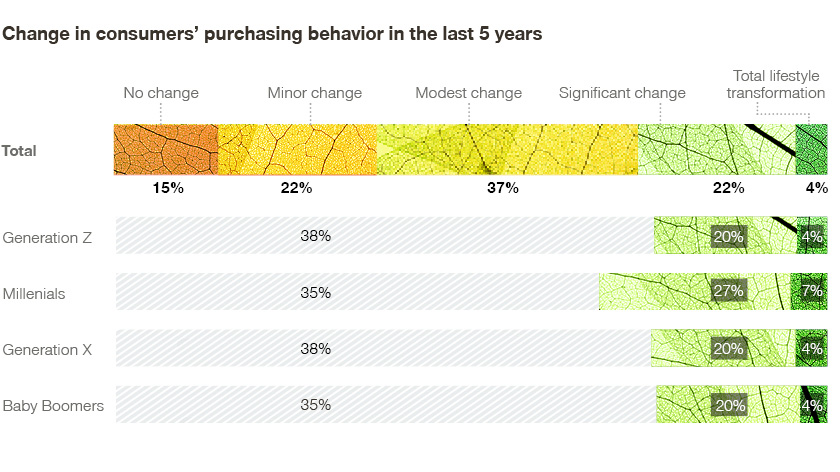
Looking at consumers’ current shopping behavior, we see a similar picture: For 29 percent of consumers on average, sustainability plays a role when making purchase decisions. Again, the generation differences are visible; more than 30 percent of Millennials always choose a sustainable alternative when available. Older generations are less likely to actively choose sustainable products: 29 percent of Generation X and only 24 percent of Baby Boomers said they would choose sustainable alternatives when available.
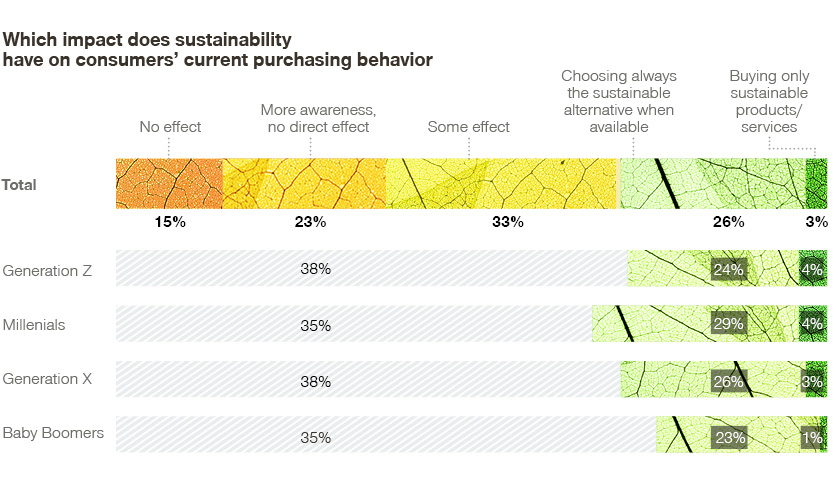
How important is sustainability as a purchase criteria?
Sustainability comes in many different shapes and sizes – spanning resource preservation, use of renewable energy sources, and emissions generated, or using more efficient technology like drones to reduce multiple factors at once.. So how do consumers choose where to focus?
We asked our study respondents how they prioritized different aspects of sustainability based on the UN Sustainability Development Goals. Across the globe, we didn’t see any difference in importance, and goals pertaining to social and environmental causes were equally important (77 to 78 percent). However, when we honed in on consumers’ shopping behavior in different industries, we were able to detect differences. In a vacuum, sustainability is a much more important criterion for consumers when looking for an energy/utilities provider or a new car compared to, e.g., financial services.
This raises the question of whether consumers fully understand how to assess and measure the sustainability of a particular industry. Our study shows how consumers use defaults or proxies to facilitate their decision-making. For example, when consumers think of sustainability for physical goods, they assume products to be especially durable, but in the energy sector they equate sustainability to low emissions. The different application of proxies would therefore explain the varying importance across industries.
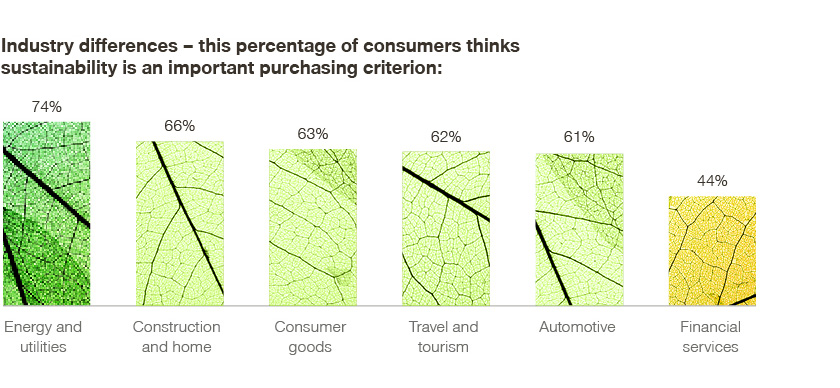
Does a focus on sustainability translate into higher willingness to pay?
More sustainability, more spending? Potentially, but not necessarily. Our survey respondents consider sustainability to be an increasingly important purchase criterion. Today, 50 percent of consumers rank sustainability as a top five value driver, and we believe it will only grow in importance. However, this doesn’t necessarily translate into spend.
Some consumers are willing to stretch their budgets to receive more sustainable products. On average, over a third are willing to pay more for sustainability, considering a 25 percent premium to be acceptable.
Again, we see a significant generational gap: Around 40 percent of Generation Z and Millennials are ready to pay for sustainability. Among Generation X and Baby Boomers, this number is roughly 30 percent or even lower. The two younger generations would accept a price premium of over 30 percent, which is more than twice as much as Baby Boomers would find reasonable.
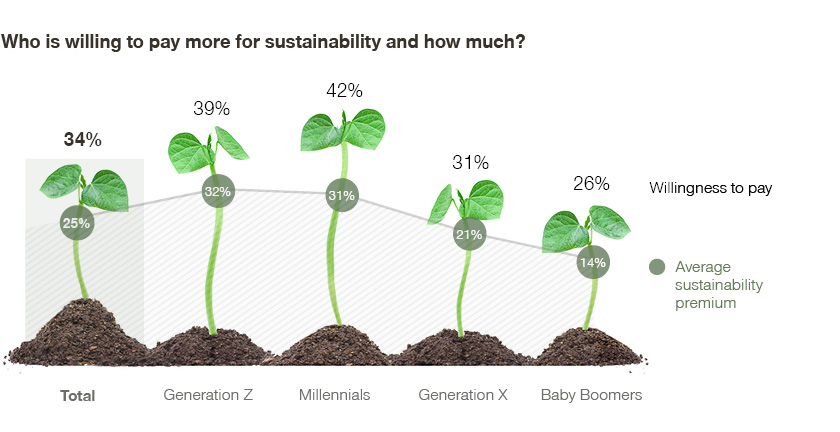
Why sustainability is important in business
When it comes to a more sustainable future, consumers know who has the most important role to play: themselves. Our study showed that civil society is seen as the number one actor in bringing about positive environmental change. All companies have to do is to act on growing sustainable trends and start presenting consumers with attractive sustainable offerings. Easy, right?
As the results of our study show, sustainability is not merely a question of a company’s ability to improve or expand its product range. Very soon, it might be a deciding factor for a company’s financial survival, as consumers increasingly “vote with their wallets”.
How should companies respond to the sustainability trend?
To guide companies in advancing their global sustainability initiatives, we have categorized the commercial implications in three phases:
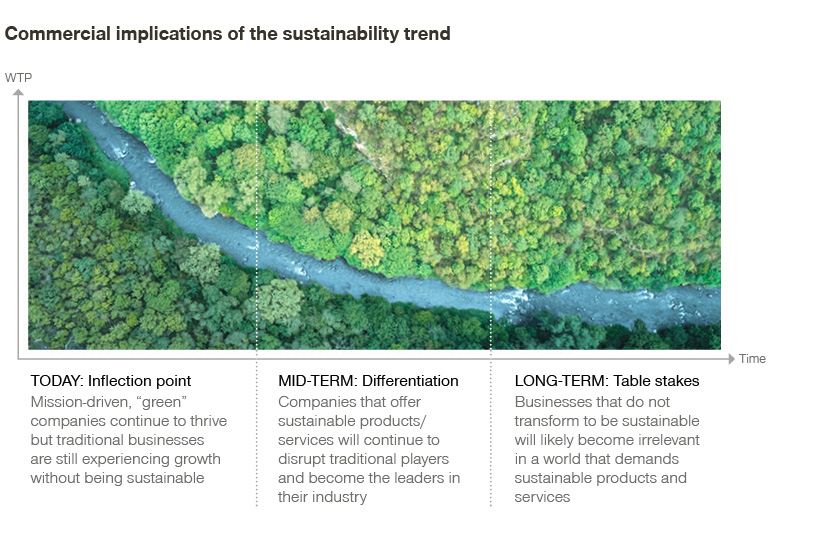
- Today: Still possible to grow without sustainable practices
Mission-driven, “green” companies continue to thrive but business as usual is not negatively affected. Meanwhile, although the number of consumers who care about sustainability continues to grow, there is a downward trend in the number of consumers willing to pay more. This is likely because sustainability will continue to become more of a differentiator rather than a premium that only select consumers pay more for. - Mid-term: Companies that differentiate become industry leaders
Offering sustainable products at competitive prices, gives mission-driven and traditional companies a competitive advantage and enables them to capture market share from their competitors. - Long-term: Sustainable business practices are key to survival
Sustainability will become a table stakes value driver. Consumers see sustainable business products and services as an expectation rather than the exception, and companies will have a hard time selling without them.
Conclusion: Transform and invest today to stay relevant tomorrow
The world is changing, and so are consumers’ attitudes toward sustainability. Many consumers are ready to pay a premium, and will adapt their purchase behavior in order to fulfil their own sustainability goals. On the downside: This won’t last very long, as sustainability will eventually become more of a hygiene factor than an extra. In order to continue growing and remain relevant, companies must recognize this trend and invest in sustainable business practices today, rather than wait until a tomorrow that never comes.








